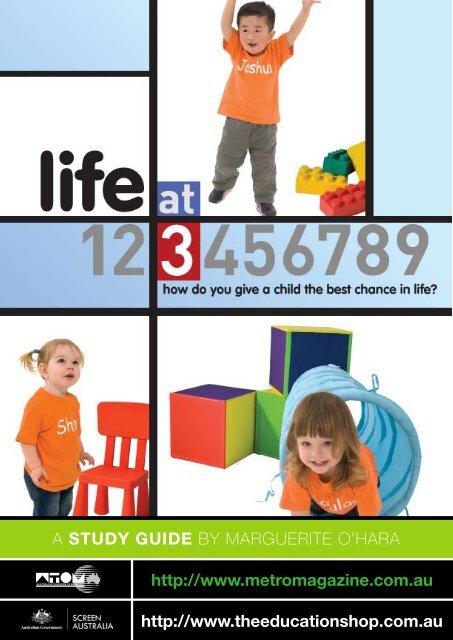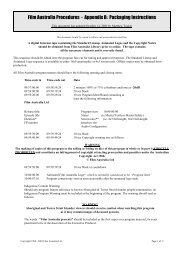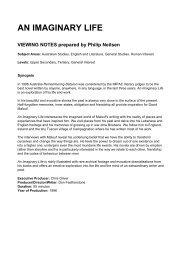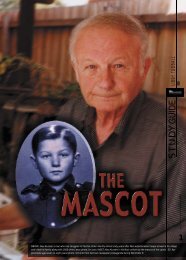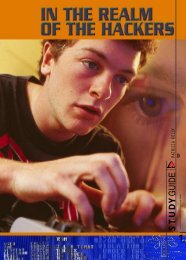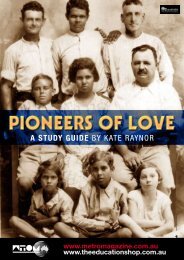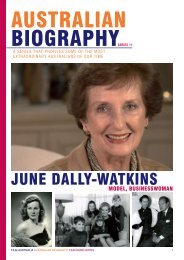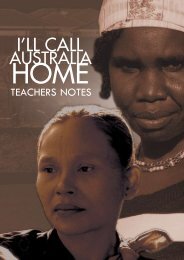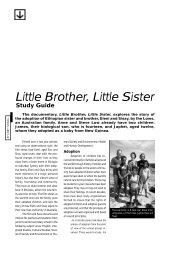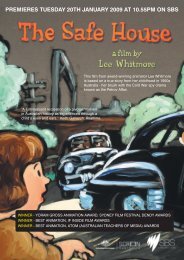Teachers Notes
Teachers Notes
Teachers Notes
You also want an ePaper? Increase the reach of your titles
YUMPU automatically turns print PDFs into web optimized ePapers that Google loves.
A STUDY GUIDE by marguerite o’hara<br />
http://www.metromagazine.com.au<br />
http://www.theeducationshop.com.au
What does it take to<br />
give a child the best<br />
chance in life<br />
Series synopsis<br />
The story continues for the<br />
children of the Life series –<br />
now they are three – as they<br />
reveal what it takes to give a<br />
child the best chance at life.<br />
Over two episodes, Life at<br />
3 measures our group of<br />
children against the latest<br />
scientific findings on two of<br />
the hottest topics in child<br />
development – obesity and<br />
bad behaviour.<br />
The Life series is made in<br />
conjunction with a longterm<br />
study – Growing Up<br />
in Australia – in which<br />
10,000 children have been<br />
placed under a sociological<br />
and scientific microscope.<br />
Combining powerful and<br />
intimate stories with cutting<br />
edge science, the series aims<br />
to reveal the secrets of child<br />
development.<br />
The longitudinal study has<br />
found that 25 per cent<br />
of toddlers are already<br />
overweight or obese – the<br />
most significant health issue<br />
facing Australian children.<br />
Life at 3 seeks answers to<br />
the problem using the latest<br />
biological and behavioural<br />
science. Research also<br />
shows that children must<br />
start to learn how to control<br />
their behaviour at three if<br />
they are to perform well<br />
at school.<br />
As the lives of these children<br />
unfold, we see whether the<br />
hopes of their parents and the<br />
predictions of the scientists<br />
match reality.<br />
Join us on the greatest<br />
journey of all – life.<br />
Curriculum<br />
relevance<br />
This program will have interest<br />
and relevance for middle to<br />
senior secondary and tertiary<br />
students in the following<br />
curriculum areas:<br />
• Biology<br />
• Child and Family Services<br />
• Community and Family<br />
Studies<br />
• Exploring Early Childhood<br />
(Secondary)<br />
• Early Childhood Studies<br />
(Tertiary)<br />
• General Science<br />
• Health and Human<br />
Development<br />
• Psychology<br />
• Sociology<br />
• SOSE/HSIE<br />
• Values Education<br />
Apart from its direct relevance<br />
to these learning areas, Life<br />
at 3 paints a fascinating<br />
picture of Australian society<br />
in all its diversity. In 2006,<br />
Life at 1 introduced viewers<br />
to 11 babies and their<br />
families, all from very different<br />
backgrounds. The joys and<br />
struggles of these families are<br />
shown with sensitivity and<br />
warmth. Comparisons with<br />
Michael Apted’s Seven Up<br />
2
films are inevitable but this<br />
series looks at children from<br />
birth to seven, and employs<br />
a more deliberately scientific<br />
approach. This is ‘reality TV’<br />
of an altogether different<br />
order from much of what we<br />
are shown on television, but<br />
nonetheless absorbing and<br />
moving for that.<br />
Note: Life at 3 has received<br />
a PG (Parental Guidance<br />
Recommended) classification,<br />
with the consumer advice:<br />
Mild themes, Infrequent coarse<br />
language.<br />
Life at 3<br />
This is the second instalment<br />
in this landmark series that<br />
follows 11 babies and their<br />
families for seven years to<br />
discover what it takes to give<br />
a child the best chance at life.<br />
One of the babies who took<br />
part in Life at 1, along with her<br />
family, does not appear in this<br />
second part, but will return in<br />
Life at 5.<br />
While it would probably be<br />
preferable for students to<br />
have watched Life at 1, there<br />
is sufficient recapitulation<br />
in the form of background<br />
information in these two<br />
episodes about the children<br />
in their third year of life for the<br />
programs to stand alone and<br />
make perfect sense.<br />
Introduction<br />
We were all toddlers once<br />
but most of us probably<br />
have few clear memories of<br />
those early years. Apart from<br />
photos and family stories, we<br />
only have the person we are<br />
now to provide us with clues<br />
about our earliest years of life.<br />
Some of us may have younger<br />
brothers and sisters whom<br />
we watched grow up and<br />
thus have a more immediate<br />
awareness of toddlers. These<br />
programs continue the study<br />
of 10 of the children and their<br />
families we met in Life at 1;<br />
their parents are interviewed<br />
and the toddlers are observed<br />
and tested as they play and<br />
grow. The programs are<br />
made in conjunction with<br />
a longitudinal study being<br />
carried out by the Australian<br />
Institute of Family Studies<br />
which is following 10,000<br />
children between birth and<br />
age seven. The episodes in<br />
Life at 3 are Fighting Fat and<br />
Bad Behaviour.<br />
Background<br />
information<br />
1. How the series came<br />
about, the background and<br />
rationale for the large scale<br />
longitudinal study and how<br />
the families were chosen<br />
The Longitudinal Study<br />
of Australian Children<br />
(LSAC) was initiated by<br />
the Australian Government<br />
Department of Family and<br />
Community Services as part<br />
of the ‘Stronger Families and<br />
Communities Strategy’. The<br />
Australian Institute of Family<br />
Studies is responsible for<br />
the design and management<br />
of the study. During 2004,<br />
10,000 children and their<br />
families were recruited to<br />
the study from a sample<br />
selected from the Health<br />
Insurance Commissioner’s<br />
Medicare database. About 300<br />
postcodes were selected at<br />
random across the country and<br />
then a number of children were<br />
selected from these. Around<br />
18,800 families in total were<br />
sent an invitation to participate.<br />
Six behavioural and biological<br />
science design teams are<br />
researching the areas of<br />
health, education, childcare,<br />
family functioning, child<br />
functioning and sociodemographics<br />
in the lives<br />
of the 10,000 children and<br />
their families. They include<br />
sociologists, educationalists,<br />
paediatricians, psychologists,<br />
statisticians, epidemiologists<br />
and experts in early<br />
childhood, temperament and<br />
mental health of populations.<br />
There is also a Scientific and<br />
Policy Advisory Group of<br />
international experts on child<br />
development.<br />
The first phase of the study<br />
commenced in March 2004<br />
and the analysis of the data<br />
from this first wave was<br />
released in May 2005.<br />
3
A ‘between waves’<br />
questionnaire was sent to the<br />
10,000 families in May 2005<br />
and analysis of this update data<br />
was released in August 2006.<br />
The second full wave of<br />
data collection commenced<br />
in March 2006 and LSAC<br />
expects to release early<br />
analysis in August 2007.<br />
* The above information is<br />
taken from the Longitudinal<br />
Study of Australian Children<br />
2004 annual report and advice<br />
from the Australian Institute of<br />
Family Studies.<br />
2. How representative of<br />
Australian society are the 11<br />
families in the series and how<br />
do these families mirror the<br />
families in the major study<br />
We selected families that not<br />
only mirrored the lives and<br />
experiences of the 10,000<br />
families in the Longitudinal<br />
Study of Australian Children<br />
(LSAC), but also reflected the<br />
major findings in the first wave<br />
of information collected by this<br />
landmark study.<br />
For example, Declan represents<br />
the 30 per cent of children<br />
in the study who attend a<br />
childcare centre before they are<br />
one year old. And Anastasija<br />
represents the 35 per cent of<br />
children whose parents and<br />
grandparents juggle childcare<br />
around work commitments.<br />
Sofia is the child who mirrors<br />
the rising trend in upper middle<br />
class families to use an in-home<br />
nanny. Wyatt represents the<br />
children who have a mix of<br />
carers – grandparents, formal<br />
childcare and parents – and<br />
who are going from one<br />
carer to another at least<br />
five days a week.<br />
We were also looking for<br />
children growing up in a mix of<br />
family types: Lots of brothers<br />
and sisters as in Jara’na and<br />
Ben’s stories; single children<br />
like Loulou, Anastasija, Haleema<br />
and Declan; a child with stepbrothers<br />
and sisters as Shine<br />
has; small families – as for Joshua,<br />
Sofia and Daniel – and the child<br />
of teenage parents like Wyatt.<br />
To reflect the growing trend of<br />
older mothers, we wanted a<br />
range of ages in our mums. And<br />
within all of this mix we were<br />
after a diversity of economic<br />
and cultural backgrounds –<br />
always trying to reflect the<br />
spread in the 10,000 families.<br />
– Catherine Marciniak and<br />
Jennifer Cummins, Director<br />
and Producer of the series<br />
How were the families<br />
recruited<br />
We made up flyers and leaflets<br />
and we put them up at baby<br />
health clinics, in preschools,<br />
at Centrelink; we advertised in<br />
baby magazines and online<br />
groups. We accessed outback<br />
Australia through some of<br />
the parenting support<br />
groups out there.<br />
We approached<br />
disability groups;<br />
we used a lot<br />
of community<br />
organisations to<br />
get the word out.<br />
When you put out<br />
for volunteers for<br />
something like<br />
4
this there are certain groups<br />
that generally won’t respond<br />
because they’ve got too much<br />
on their plate – like teenage<br />
parents for instance, or the<br />
types of families that publicity<br />
doesn’t access. So we’ve got<br />
a few families we actually<br />
sought out.<br />
– Jennifer Cummins, Producer<br />
3. The experts featured in<br />
Life at 3<br />
Professor Stephen Zubrick<br />
– Chair, Advisory Group,<br />
Longitudinal Study of<br />
Australian Children.<br />
He is the Head of the Division<br />
of Population Sciences<br />
research at the Telethon<br />
Institute for Child Health<br />
Research and Professor,<br />
Centre for Developmental<br />
Health, Curtin Institute of<br />
Technology. His research<br />
interests include the study of<br />
the determinants of health and<br />
mental health in children.<br />
Professor Gary Wittert—<br />
Head, School of Medicine,<br />
University of Adelaide.<br />
He is the Life series’ expert on<br />
the biology of obesity.<br />
Professor Tim Olds—<br />
Director, Kids Eat Kids Play<br />
National Survey.<br />
His research work focuses on<br />
trends in the fitness, fatness<br />
and physical activity of<br />
children.<br />
Professor Ann Sanson—<br />
Principal Scientific Adviser,<br />
Longitudinal Study of<br />
Australian Children.<br />
She is a developmental<br />
psychologist whose<br />
main research interests<br />
are concerned with the<br />
interplay of intrinsic child<br />
characteristics and family<br />
and contextual factors in the<br />
development of good and<br />
poor psychosocial adjustment.<br />
4. How demanding is the<br />
making of the series on the<br />
families<br />
Frequently Asked Questions<br />
(FAQs) and the filmmakers’<br />
answers:<br />
Were the families paid to be<br />
part of the series<br />
No … they could see how<br />
they and their children could<br />
play an important role in us<br />
understanding more about our<br />
kids. There is also an element<br />
of them doing this out of the<br />
goodness of their hearts.<br />
– Jennifer Cummins, Producer<br />
How intrusive is the research<br />
and filming process<br />
We said that we would<br />
probably be filming each<br />
family for three to four days to<br />
start with … but for some we<br />
needed to take more time.<br />
We were quite rigorous about<br />
making sure people were<br />
potentially in for the long haul.<br />
– Catherine Marciniak and<br />
Jennifer Cummins,<br />
Director and Producer<br />
What happened when all the<br />
families met for the first time<br />
There was a huge curiosity<br />
amongst all of them … Some<br />
of the families felt they were<br />
a little bit token – the token<br />
inner-city family, the token<br />
rural family or IVF or teenage<br />
– but when they got there<br />
they realized that everybody<br />
was ‘token’ and was there to<br />
represent a broad spectrum of<br />
Australia.<br />
– Catherine Marciniak,<br />
Director<br />
5
Before watching<br />
Activity 1<br />
1. What information do you have in the form of photos, video<br />
and family stories about your third year of life<br />
2. What has your family told you about what you were like as a<br />
toddler<br />
3. How many brothers and sisters do you have, and what<br />
number are you in the family order<br />
4. Have you thought about having children at some time in the<br />
future or do you think this is not something you would want<br />
to do in your life<br />
5. If you were to have children, what do you think would be the<br />
most appropriate age to become a parent<br />
6. What would you like to do before you think about having<br />
children<br />
7. How important do you think it is to establish a stable<br />
emotional and financial environment in which to have a<br />
child<br />
8. Describe any experiences you have had looking after<br />
young children, whether siblings, other relatives or through<br />
babysitting. What were some of the challenges<br />
Who are the toddlers and their families in<br />
Life at 3<br />
Toddler<br />
Parents<br />
Episode 1 Ben Kylie and Paul<br />
Shine<br />
Joshua<br />
Sofia<br />
Loulou<br />
Michelle and Alain<br />
Steffi and Garry<br />
Bernadette and Anthony<br />
Louise and Shannon<br />
Episode 2 Daniel Kathryn and Rodney<br />
Declan<br />
Anastasija<br />
Jara’na<br />
Wyatt<br />
Kim and Patrick<br />
Kathy and Darren<br />
Michelle and Paul<br />
Tamara and Glenn<br />
6
Activity 2<br />
Suggested ways to<br />
watch the film<br />
Five of the children and<br />
their families are featured in<br />
Fighting Fat and the other five<br />
children are the focus of Bad<br />
Behaviour. You could divide<br />
your class into five groups,<br />
with each group concentrating<br />
their attention on one of the<br />
children and their parents in<br />
each of the two episodes.<br />
For each child, your group<br />
could further allocate specific<br />
aspects to focus on:<br />
1. How the child’s<br />
temperament and<br />
behaviour is shown to have<br />
changed and developed<br />
over the two years since<br />
they were last observed<br />
and filmed.<br />
2. The care arrangements for<br />
the child in its third year of<br />
life, including the child’s<br />
connections with other<br />
adults in its world.<br />
3. General impressions of the<br />
child’s personality.<br />
4. Current economic position<br />
of the parents and the<br />
family structure.<br />
5. Factors that may impact<br />
on the child’s chances of<br />
becoming overweight.<br />
Fighting Fat<br />
episode synopsis<br />
Discover why one in four<br />
toddlers is getting too fat and<br />
what it takes to keep a child a<br />
healthy weight.<br />
Can science explain why<br />
quintuplet Ben, the tiniest of<br />
toddlers, is at risk of being<br />
overweight as an adult<br />
Does looking into Joshua’s<br />
ancestry reveal why some<br />
kids eat too much Will Shine<br />
be at risk of becoming obese<br />
simply because she lives<br />
in a low-income postcode<br />
A longitudinal study of<br />
Australian children has found<br />
that biology is only part of the<br />
childhood obesity story.<br />
Life at 3: Fighting Fat<br />
breaks the latest science<br />
on the biggest health issue<br />
facing Australian children. It<br />
pinpoints key factors – some<br />
surprising – about why our<br />
kids are getting too fat.<br />
While watching<br />
In this section of the guide<br />
there are five sets of questions<br />
specific to each child though<br />
there are some common<br />
factors. Make brief notes on<br />
these questions about your<br />
child as you watch Fighting<br />
Fat and afterwards you could<br />
share your information.<br />
7
1. Ben<br />
After Jack, Ben would probably be the next one<br />
that eats the most even though he’s tiny, but to<br />
me he’s catching up.<br />
– Kylie, Ben’s mum<br />
The smallest of quintuplets, Ben lives in a<br />
household of devoted carers and has overcome<br />
myriad health problems and development<br />
delays resulting from his premature birth. But<br />
as the tiniest of quintuplets with a birth weight<br />
of just 500 grams, Ben is one of the biggest<br />
eaters in his family and science suggests he<br />
could be at a high risk of becoming obese.<br />
• According to recent research, how many<br />
Australian toddlers are already overweight<br />
or obese<br />
• What is the number one predictor for a child<br />
becoming fat<br />
• What happened to Ben in his first six<br />
months of life<br />
• How did this experience affect his early<br />
development<br />
• Why might Ben now be cleaning up the<br />
bowls and leftovers of his brothers and<br />
sisters<br />
• What does the research reveal about the<br />
appetites of low birth-weight babies<br />
• What is the inevitable result of eating<br />
energy dense and nutrient poor foods and<br />
expending little energy<br />
• What are some of the reasons the parents<br />
of Ben (and some of the other children’s<br />
parents) give for finding it hard to control<br />
their own weight<br />
• How does the evidence that our bodies are<br />
designed to store fat make long-term weight<br />
loss a more difficult task<br />
• What is the second highest predictor of a<br />
child becoming overweight<br />
8
2. Shine<br />
It’s difficult to eat [healthily] on a limited budget.<br />
No doubt about it.<br />
– Michelle, Shine’s mum<br />
Shine’s parents, Michelle and Alain, are flat<br />
broke for the second time, with a family of<br />
seven to feed and house. The family survives<br />
on welfare payments and groceries from St<br />
Vincent de Paul. For decades international<br />
research has shown that children raised in<br />
poverty are more likely to be obese. But the<br />
longitudinal study reveals this isn’t about the<br />
income of any one family, but the postcode in<br />
which they live. Will Shine’s address affect her<br />
weight<br />
• What are some of the difficulties for Alain<br />
and Michelle in providing healthy food for<br />
their children<br />
• What factors persuade them to move to a<br />
coastal area<br />
• Apart from the sheer awfulness of ‘the feeling<br />
of poverty’ for both Michelle and Alain, what<br />
are the limits of being dependent on shopping<br />
at a charity warehouse<br />
• What are some of the factors that are<br />
significant predictors for children living in<br />
poorer neighbourhoods becoming obese<br />
• What initiatives are Michelle and Alain<br />
taking to ensure that their children are<br />
not part of a poverty trap<br />
• While having a good career might<br />
mean more money and more<br />
access to food, why might this<br />
not necessarily be a good thing for<br />
families<br />
9
3. Joshua<br />
Joshua’s parents are determined he’ll never<br />
suffer [famine] like his grandmother did<br />
[during the cultural revolution in China] and<br />
even in the ‘land of unlimited food’, they’re<br />
raising him on a traditional and healthy<br />
Chinese diet.<br />
– Narrator of Life at 3<br />
At one, Joshua’s development was delayed.<br />
He could barely talk and was a long way<br />
from crawling. Now aged three, Joshua is<br />
catching up. He is a demanding and active<br />
little boy; by his second birthday he was<br />
bilingual, speaking both Cantonese and<br />
English. The longitudinal study has found<br />
that boys who speak English as a second<br />
language are three times more likely to be<br />
overweight. Could Joshua’s ancestry and a<br />
new scientific theory help to explain why<br />
her observation support the researcher’s<br />
view that ‘when there is a rapid shift from<br />
rural underprivileged hungry to urbanized<br />
overfed, with little physical activity,<br />
people are at risk of obesity’<br />
• What attempts are Joshua’s parents<br />
making to ensure he does not become a<br />
fat child<br />
• How would you account for the sharp<br />
decline in fitness around the world since<br />
1970<br />
• What research is being undertaken<br />
to map levels of physical activity,<br />
both planned and<br />
incidental, as part<br />
of this ongoing<br />
longitudinal study<br />
into children’s<br />
development and<br />
fitness<br />
• How do the researchers explain the<br />
surprising finding that ‘boys who speak<br />
English as a second language are three<br />
times more likely to be overweight’<br />
• To what do Joshua’s parents attribute his<br />
enormous developmental progress over<br />
the past year<br />
• Apart from Joshua’s physical and<br />
language development, how have his<br />
cortisol levels, a method of measuring<br />
stress levels, changed since he was<br />
tested as a baby<br />
• What is suggested by the researchers<br />
about how Joshua’s grandmother’s<br />
experience in China during the Cultural<br />
Revolution may have affected not just his<br />
mother, Steffi, but also Joshua<br />
• When Steffi visited China recently she<br />
noticed that the size of young children,<br />
who used to be quite thin, had changed<br />
and they are now very big. How does<br />
10
4. Sofia<br />
The average day of Sofia is extremely energetic.<br />
She’s a very active kid. She always involves<br />
herself in everything that’s going on.<br />
– Anthony, Sofia’s dad<br />
Sofia’s parents have always had a full life,<br />
working long hours and juggling busy careers<br />
and childcare with the assistance of a nanny.<br />
Energetic Sofia is also very active and has a<br />
calendar packed with activities including music,<br />
tennis lessons, swimming and dance classes<br />
and even a regular pedicure on her monthly<br />
‘mummy and me’ days. All this planned activity<br />
costs money, but according to the longitudinal<br />
study, it’s the ‘no-cost’ incidental activity<br />
that may help Sofia most in the battle<br />
against obesity.<br />
• How does Sofia’s busy life, filled with<br />
activities, mirror that of her parents<br />
• What do you think the scientists mean by<br />
the term ‘incidental activity’<br />
• Why might outdoor play be better for<br />
children than more sedentary indoor<br />
activities<br />
• Were you surprised by the finding that 50<br />
per cent of four- to five-year-olds watch<br />
television for more than two hours a day<br />
• What is the recommended minimum number<br />
of steps per day to maintain fitness<br />
• How many of the parents were able to reach<br />
this level of activity when they were fitted<br />
with pedometers to measure their daily step<br />
count<br />
• How does the level of activity undertaken<br />
by parents influence their children’s likely<br />
levels of activity<br />
11
5. Loulou<br />
Loulou eats just about anything when<br />
she wants to; and if she doesn’t want to,<br />
bad luck.<br />
– Shannon, Loulou’s dad<br />
A happy and healthy toddler, Loulou was an<br />
IVF baby whose birth was a dream come<br />
true for her mother. But the euphoria of<br />
Loulou’s first days at home soon faded.<br />
Over the past two years each of her parents<br />
has battled depression, a struggle that has<br />
severely tested their relationship. Loulou is<br />
the focus of her parents’ lives and makes<br />
them determined to beat their problems and<br />
keep their relationship on track. A surprising<br />
finding of the longitudinal study reveals that<br />
the way a dad parents<br />
a child could<br />
affect their<br />
weight. Could<br />
Shannon’s<br />
depression<br />
have made<br />
him a more<br />
detached<br />
and lenient<br />
parent<br />
• Apart from the stressful IVF process<br />
resulting in Loulou’s birth, what other<br />
stressful factors have there been in this<br />
family’s life<br />
• How well is Louise coping with the<br />
separation from Loulou that is part of<br />
leaving her in childcare when Louise goes<br />
back to part-time work<br />
• Louise and Shannon have no family<br />
support near where they live. How<br />
might this compound their difficulties<br />
in managing the different kinds of<br />
depression from which each has<br />
suffered<br />
• How is Loulou’s presence in this family’s<br />
life central to how important they believe<br />
it is to work through their problems<br />
• What we found in these preschool years<br />
is that a mum’s parenting style has no<br />
relationship with the child’s weight.<br />
But dad’s does. Dads who are not able to<br />
set consistent limits with their kid,<br />
and dads who are not engaged and<br />
warm with their child, are more likely to<br />
have overweight kids.<br />
– Professor Zubrick<br />
How could this statement relate to what<br />
we see of the fathers in this episode<br />
• Professor Zubrick says at the end of this<br />
episode:<br />
The most important message of the study<br />
is that the front line against obesity is the<br />
first three years of life.<br />
We can control the environment we<br />
create for kids, what they eat, how they<br />
eat, and set the patterns very early in life<br />
for the amount of activity that they do.<br />
Biology is a factor, but it’s not destiny.<br />
What do parents need to do in a<br />
child’s first three years of life<br />
12
Activity 3<br />
Class discussion<br />
questions about the<br />
issues raised in this<br />
episode<br />
This episode of Life at 3 is<br />
titled Fighting Fat. Conduct a<br />
class discussion about why<br />
the researchers see this as<br />
a major challenge in giving<br />
a child ‘the best start in life’.<br />
Again, you could allocate<br />
different areas of this topic<br />
to groups to conduct their<br />
own research, both online<br />
and from your own research<br />
and experience. Incorporate<br />
both scientific and anecdotal<br />
evidence from this program<br />
in your discussion. Here are<br />
some elements to consider:<br />
1. The statistical information<br />
that supports the theory<br />
that obesity is a growing<br />
and serious health issue<br />
today, particularly in<br />
affluent western countries.<br />
2. The importance of early<br />
intervention and early habit<br />
forming in relation to food<br />
and exercise as the best<br />
way to change behaviours.<br />
3. The responsibility (if any)<br />
governments have to assist<br />
communities in avoiding<br />
obesity and increasing<br />
people’s energy output<br />
through exercise.<br />
4. The role of advertising,<br />
particularly snack and<br />
junk food advertising,<br />
during children’s television<br />
programs. (See the Life at<br />
3 website for an interview<br />
with one of the scientists<br />
who conducted a study<br />
on the ‘paradoxical buying<br />
behaviour’ of parents.)<br />
5. The role and responsibility<br />
of schools, both for foods<br />
sold in school canteens<br />
and in the range of regular<br />
exercise encouraged or<br />
mandated. You could<br />
look at celebrity chef<br />
Jamie Oliver’s work to<br />
change the composition<br />
of school dinners in<br />
England, the work of<br />
Stephanie Alexander to<br />
establish kitchen gardens<br />
in Melbourne schools, the<br />
walking school buses, the<br />
way homework might limit<br />
outdoor activities. (See<br />
the Life at 3 website for<br />
a checklist for home and<br />
neighbourhood.)<br />
6. The role of cooking shows<br />
and magazines and books<br />
with their focus on food<br />
and cooking as a key<br />
element in a fashionable<br />
lifestyle. Do they inflate the<br />
role of food in our lives<br />
7. Where does the research<br />
suggest early intervention<br />
is most important Are<br />
particular individuals<br />
or groups of children<br />
more likely to become<br />
overweight than others<br />
(See the Life at 3 website<br />
as a starting point.)<br />
8. How can we teach people<br />
to develop a healthy<br />
approach to eating and<br />
exercise that is neither too<br />
‘food centred’ nor overly<br />
obsessed with weight<br />
management and<br />
control<br />
SCREEN EDUCATION 13
How closely did you<br />
watch<br />
Quick quiz about<br />
Fighting Fat<br />
1. How many of the toddlers<br />
in this episode have<br />
brothers and/or sisters<br />
2. Which of the toddlers<br />
attend regular outside child<br />
care<br />
3. Whose dad was in<br />
remission from a serious<br />
illness during their first<br />
months of life<br />
4. Which child is said to be a<br />
‘daddy’s girl’<br />
5. Who was the smallest child<br />
at birth<br />
6. What are the two strongest<br />
predictors of childhood<br />
obesity<br />
7. Whose mum and dad are<br />
going back to study to<br />
develop new careers<br />
8. Which child bypassed<br />
crawling and walked at 17<br />
months<br />
9. Whose mum exceeded the<br />
10,000 steps per day<br />
10. Whose parents are learning<br />
to cope with depressive<br />
illnesses<br />
(Answers are on page 28.)<br />
Bad Behaviour<br />
episode synopsis<br />
This episode investigates<br />
toddlers’ ability to control their<br />
behaviour; science reveals<br />
that this has a significant<br />
impact on their success at<br />
school.<br />
Using a simple experiment, we<br />
test the ability of five toddlers<br />
to control their behaviour.<br />
Will Declan’s good language<br />
skills and his father’s positive<br />
reinforcement help him to<br />
learn to curb his tantrums<br />
Will Daniel’s resilience and his<br />
ability to focus his attention<br />
help him to survive a family<br />
tragedy Science suggests<br />
that the 15 per cent of children<br />
living apart from one parent<br />
are at the highest risk of bad<br />
behaviour. Is Wyatt destined<br />
to behave badly because his<br />
parents have split up<br />
Drawing on the latest scientific<br />
research on childhood<br />
behaviour, Bad Behaviour<br />
shows how the ordinary and<br />
the most challenging hurdles<br />
of life can affect a child’s<br />
behaviour, and what they need<br />
to learn to control it.<br />
SCREEN EDUCATION 14
Activity 4<br />
As with Fighting Fat, there<br />
are five sets of questions<br />
specific to each child relating<br />
to this episode, though there<br />
are some common factors.<br />
Make brief notes on these<br />
questions about your child as<br />
you watch this episode and<br />
afterwards you could share<br />
your information.<br />
Five of the children and their<br />
families are featured in Bad<br />
Behaviour. You could divide<br />
your class into five groups,<br />
with each group concentrating<br />
their attention on one of the<br />
children and their parents –<br />
Daniel, Declan, Anastasija,<br />
Jara’na and Wyatt.<br />
For each child your group<br />
could further allocate specific<br />
aspects to focus on:<br />
1. How the child’s<br />
temperament and<br />
behaviour is shown to have<br />
changed and developed<br />
over the two years since<br />
they were last observed<br />
and filmed.<br />
2. The minding arrangements<br />
for the child in its third year<br />
of life, including the child’s<br />
connections with other<br />
adults in its world.<br />
3. General impressions of the<br />
child’s personality.<br />
4. Current economic position<br />
of the parents and the<br />
family structure.<br />
5. Factors that might make<br />
controlling behaviour more<br />
challenging for the child.<br />
15
1. Daniel<br />
Tensions in Daniel are very interesting. He gets<br />
very cranky very easily … but they’re very short<br />
lived. Daniel’s favourite word No.<br />
– Kathryn and Rodney, Daniel’s parents<br />
In his three short years, Daniel has experienced<br />
life’s greatest hardships after a drowning<br />
accident left his older brother with severe brain<br />
damage. His parents’ marriage has suffered<br />
and Daniel’s wellbeing is also at risk. He has<br />
changed from a well-adjusted one-year-old<br />
to a toddler who is waking up in tears, afraid<br />
of the anger he is witnessing in his parents’<br />
relationship. The longitudinal study has found<br />
boys have more difficulty managing their<br />
emotions during a family crisis. Could resilience<br />
help Daniel through these difficult times<br />
• What is the traumatic and tragic element in<br />
his family’s life that Daniel has lived with for<br />
most of his life<br />
• How is the situation with Jamie affecting the<br />
parents’ relationship<br />
• How do these tensions affect Daniel<br />
• What are Rodney and Kathryn determined<br />
to do to ensure Daniel’s emotional needs are<br />
met<br />
• How does Daniel help his parents deal with<br />
their grief<br />
• How does Daniel demonstrate his capacity<br />
for resilience in the experimental playroom<br />
activity<br />
• What changes has Rodney made to<br />
his life and time management that will<br />
be positive for all the family<br />
16
2. Declan<br />
He just can’t cope with any change. We can<br />
have two hours of crying just triggered off<br />
because he had one purple knife and an orange<br />
fork. To keep the peace in the household it’s<br />
just easier to run with how Declan likes it.<br />
– Kim, Declan’s mum<br />
An outgoing, active three-year-old with good<br />
language skills, Declan has always had a<br />
predictable life. He is so fixated on routine that<br />
his parents joke he is obsessive compulsive.<br />
But Declan suffers a huge change to his routine<br />
when his parents bring home a baby brother,<br />
ending life as he knows it and triggering<br />
frequent and intense tantrums. If it continues,<br />
the behaviour will make it difficult for Declan<br />
to make and keep friends. Life at 3 conducts a<br />
behavioural science experiment to test whether<br />
Declan has what it takes to learn how to control<br />
his tantrums.<br />
• How do Declan’s parents describe his<br />
personality<br />
• Where has Declan spent four days a week<br />
since he was a baby<br />
• What big change has recently happened in<br />
Declan’s life<br />
• How has his behaviour changed in response<br />
to this change in the family structure and his<br />
own routines<br />
• Does Declan show that he is able to<br />
regulate his behaviour in the playroom<br />
experiment<br />
• What is the crucial factor in helping him<br />
respond to the request to pack up the toys<br />
• How are Declan’s excellent language skills<br />
thought to help him manage his behaviour<br />
• What is his response to his mother’s<br />
question about whether they should keep<br />
the baby Do you think this is typical of<br />
young children who have had their parent’s<br />
undivided attention for several years<br />
17
3. Anastasija<br />
Anastasija’s the most frustrating and the most<br />
lovable thing you’d ever meet … Tantrums. You<br />
know the whole neighbourhood knows when<br />
she’s having one. She’s a clown. She makes me<br />
laugh.<br />
– Kathy and Darren, Anastasija’s parents<br />
An energetic and feisty child, Anastasija has<br />
been protected and cared for by only her<br />
parents and grandparents. She is confident and<br />
fearless. But in Life at 1 we predicted that life<br />
surrounded by doting carers could make this<br />
feisty toddler intolerant of anything she doesn’t<br />
like doing – a prediction we put to the test on<br />
Anastasija’s first day at pre-school.<br />
• Who has cared for Anastasija on a daily<br />
basis since birth<br />
• How does she express her confident<br />
exuberance in her own environment<br />
• What is Kathy anxious about as Anastasija<br />
is about to start pre-school<br />
• Is this concern vindicated by what we see of<br />
Anastasija on her first day at pre-school<br />
• How is her adventurous spirit shown in her<br />
behaviour and approach to activities at preschool<br />
• … the ability to focus attention is helpful<br />
for a child at school. And recent research is<br />
showing us that the ability to focus<br />
attention, both on the boring and on<br />
the fun, may well be more important<br />
than intelligence in order for kids to<br />
do well.<br />
– Professor Zubrick<br />
What are the positive signs that<br />
Anastasija will learn to focus her<br />
attention in situations she may<br />
initially find pointless<br />
18
4. Jara’na<br />
Well, he was just outgoing when he was<br />
younger, and then he went back into his shell,<br />
and he was very withdrawn and only wanted<br />
to spend time with mum. He didn’t want to get<br />
involved with anything outside of his known<br />
environment.<br />
– Paul, Jara’na’s dad<br />
An inquisitive, confident and imaginative boy,<br />
Jara’na’s behaviour at three is very different<br />
from his behaviour at one. Initially outgoing and<br />
social, he has become clingy and withdrawn,<br />
happy only when his mother is beside him.<br />
Will Jara’na’s ability to project himself into<br />
the future and a capacity to focus his mind<br />
help him to learn to control his tears, or is this<br />
behaviour an indication of how he will deal with<br />
the highs and lows of life<br />
• What special qualities did Jara’na<br />
demonstrate as a one-year-old when he was<br />
first filmed in Life at 1<br />
• At what age does Jara’na’s mum say he<br />
started to become ‘really clingy’<br />
• What is the one major change that has<br />
occurred in Jara’na’s life that might explain<br />
this change in his behaviour<br />
• How do the workers at the childcare<br />
centre help Jara’na to settle<br />
• When he is with his dad in the play<br />
room experiment, how does he respond<br />
to this separation from his mum<br />
• What skill does Jara’na exhibit when<br />
he cheerfully packs up the toys to move<br />
on to another experience<br />
• In what ways is this ability to ‘delay<br />
gratification’ seen to be a maturing sign<br />
in children learning to manage their<br />
behaviour<br />
19
5. Wyatt<br />
Wyatt’s two households are less than five kilometres apart<br />
and this might make a big difference in how well this little boy<br />
negotiates his parents’ break-up.<br />
– Narrator<br />
Wyatt’s teenage parents separated when he was 17 months<br />
old, placing him at a high risk of ‘bad behaviour’. In the<br />
months following the separation, Life at 3 witnesses conflict<br />
over the unpredictable contact Wyatt has with his father.<br />
The longitudinal study has shown this can lead to behaviour<br />
problems in children. But while money is short and custody<br />
arrangements are fluid, Wyatt appears unfazed, happily<br />
adapting to the changes in his life. Could having his parents<br />
living close to each other, and his own temperament, help<br />
Wyatt emotionally deal with the break up of his parents<br />
• How does Tamara describe Wyatt’s personality<br />
• What were some of the pressures Tamara and Glenn were<br />
under that led them to decide it would be better for everyone<br />
if they separated<br />
• What is the ongoing conflict Tamara sees in the shared<br />
caring arrangements for Wyatt<br />
• What does Glenn have to say about his difficulties in<br />
caring for his son<br />
• Wyatt is one of about 15 per cent of the 10,000 children<br />
in this longitudinal study who lives apart from one of his<br />
parents. Why are these children of particular interest to the<br />
study of behaviour<br />
• How do Tamara’s new living arrangements in a share house<br />
provide positive relationships for both Tamara and Wyatt<br />
• What does the study of children living apart from one<br />
parent suggest about the best circumstances for spending<br />
time with both parents after separation<br />
• How much time each week does Wyatt spend<br />
with his dad<br />
• What does Professor Sanson think about how Wyatt is<br />
responding to his family situation at this stage in his life<br />
• What is meant by her observation that ‘risk is not<br />
destiny’<br />
20
Activity 5<br />
Class discussion questions<br />
about the issues raised in this<br />
episode<br />
• Towards the end of this<br />
episode about toddler<br />
behaviour, Professor<br />
Zubrick says:<br />
The study’s not looking<br />
for perfect parenting; it’s<br />
looking at how parenting<br />
happens, and in doing that<br />
there was a very important<br />
discovery in the data. We<br />
found that when parents<br />
make even relatively small<br />
changes in their parenting<br />
style, and by that I mean<br />
are a little more warm, a<br />
little more engaged and<br />
consistent with their kid,<br />
those changes translate<br />
into really significant and<br />
better outcomes for their<br />
child. So what that’s telling<br />
us is that we don’t have<br />
to be super parents, we<br />
just have to make small<br />
changes and be more<br />
flexible in our parenting<br />
styles.<br />
What do we see in this<br />
episode of the significance<br />
of ‘small changes’ in<br />
parenting, particularly<br />
in relation to Daniel and<br />
Wyatt<br />
• In any family with more<br />
than one child, each<br />
will display individual<br />
personality traits.<br />
Anecdotally, parents will<br />
report that while the first<br />
child was a bad sleeper,<br />
a fussy eater and often<br />
grizzly, their last child<br />
was easy-going and<br />
cheerful. But perhaps<br />
this is part of first-time<br />
parents’ adaptation to<br />
their new role, and their<br />
memory is sharper about<br />
their new experiences.<br />
Nevertheless, differences<br />
in children raised by the<br />
same adults in very similar<br />
circumstances point to the<br />
complexity of determining<br />
the relative parts played<br />
by nature and nurture<br />
in bringing up children.<br />
One of the topics this<br />
film investigates is the<br />
balance between nature<br />
and nurture, i.e. how much<br />
each of us is the product<br />
of our genetic inheritance,<br />
and how much the way we<br />
are brought up determines<br />
the adult we become. How<br />
well do you think Life at 3<br />
balances its study of these<br />
two aspects of childhood<br />
development Is there any<br />
reliable scientific method<br />
available for determining<br />
the relative importance<br />
of each of these factors<br />
You could investigate<br />
studies made of identical<br />
twins, separated at birth<br />
21
and reared in different<br />
environments. Note that<br />
recent studies on identical<br />
twins in utero show that<br />
even at that early stage<br />
epigenetic changes are<br />
taking place in the DNA<br />
coding; thus there is great<br />
complexity in genes. (See<br />
website references.)<br />
• What are some of the<br />
reasons given for the<br />
tendency of toddlers<br />
(sometimes called ‘the<br />
terrible twos’) to have<br />
difficulty controlling<br />
their behaviour and<br />
sometimes having<br />
tantrums and episodes<br />
of uncontrolled rage<br />
How far is a warm and<br />
predictable response by<br />
parents, and consistency<br />
in setting limits, shown<br />
to be an important factor<br />
in how parents deal with<br />
these episodes How<br />
do Declan’s parents in<br />
particular respond to<br />
his verbal and physical<br />
outbursts<br />
• What are some of the<br />
different things that happen<br />
in the lives of the children<br />
we observe in this episode<br />
that are identified as being<br />
especially stressful<br />
Nature and Nurture<br />
One of the most difficult<br />
arguments in studying<br />
childhood development is<br />
the ‘nature/nurture’ problem.<br />
It asks if a person is the way<br />
they are mentally or physically<br />
because of the genes that<br />
they inherited or because of<br />
the environment in which they<br />
were raised. Obviously we<br />
inherit a mix of the genes of<br />
our parents and we resemble<br />
them physically, but what<br />
about our personality<br />
• Are we bad-tempered<br />
because we inherited<br />
genes for intolerance<br />
and anger or because<br />
we were raised in a<br />
household of angry<br />
people and modelled<br />
our behaviour on<br />
our parents<br />
• Are we<br />
overweight<br />
because we<br />
inherited ‘fat<br />
genes’ or<br />
because<br />
we were<br />
brought<br />
up in<br />
a family of over-eaters<br />
on their poor diet and<br />
continue to eat in that<br />
way<br />
• Are we friendly and<br />
outgoing because our<br />
parents made our first few<br />
years stimulating and full<br />
of new people or because<br />
we inherited an extroverted<br />
personality at conception<br />
Some of us may like to believe<br />
that we were messed up by<br />
our parents because then it<br />
is ‘not our fault’ and we have<br />
someone to blame. However,<br />
science tends to spoil that<br />
by finding genetic flaws that<br />
we can inherit directly such<br />
as those genes which make<br />
some people more likely to<br />
become overweight. The<br />
truth is that we are a product<br />
of both our genes and our<br />
environment, but the difficulty<br />
is in working out just how<br />
much each contributes to the<br />
personality and physique of<br />
the adult.<br />
22
Classic experiments try<br />
and study people like<br />
twins who were raised by<br />
different adoptive families<br />
and they often find that<br />
they are remarkably similar,<br />
despite very different home<br />
environments. If you aren’t too<br />
impressed by your parents,<br />
this is bad news – perhaps<br />
you should have chosen them<br />
more carefully!<br />
In Life at 1 and Life at 3 the<br />
researchers and observers<br />
examine just how much the<br />
role that both genetics and<br />
the environment play in the<br />
development of a child’s<br />
personality. Now they are<br />
three, many of the children<br />
are revealing distinctive<br />
personalities which we can<br />
label quite easily with terms<br />
like ‘confident‘, ‘cautious’ or<br />
‘nervous.’ Either they have<br />
a remarkable ability to pick<br />
up on their parents’ moods<br />
or they were born with those<br />
characteristics. You will have<br />
to decide what you believe,<br />
based on the evidence<br />
presented here.<br />
• Select two of the toddlers<br />
with distinct personalities.<br />
For each one list the<br />
personality characteristics;<br />
include any other data<br />
such as family structure,<br />
parental characteristics<br />
and care arrangements,<br />
and suggest the factors<br />
that may have created that<br />
personality type under the<br />
headings ‘genetic’ and<br />
‘environmental.’<br />
How closely did you<br />
watch<br />
Quick quiz about<br />
Bad Behaviour<br />
1. How many of the five<br />
children in this episode are<br />
only children<br />
2. Which child now has a<br />
new baby in his life<br />
3. Who finds separating from<br />
his mother difficult<br />
4. Which child moves<br />
between two households<br />
5. Whose parents are moving<br />
house in this episode<br />
6. Whose mum is concerned<br />
about their child’s<br />
transition to some outside<br />
day care<br />
7. Which child is fascinated<br />
by how things work<br />
8. Which child has been<br />
in regular day care the<br />
longest<br />
9. Whose parents are the<br />
youngest<br />
10. Who has the most<br />
brothers and sisters<br />
(Answers are on page 28.)<br />
Production<br />
story about the<br />
Life series<br />
Read the statement on pages<br />
24–25 where the director and<br />
producer talk about some of<br />
the challenges and delights of<br />
this long-term project.<br />
23
Production story<br />
As the director of the Life<br />
series, Catherine Marciniak<br />
has spent the past three years<br />
working with 11 toddlers<br />
and their families, chosen to<br />
reflect the Longitudinal Study<br />
of Australian Children being<br />
conducted by the Australian<br />
Institute of Family Studies.<br />
She has been in their<br />
bedrooms at 4am, witnessed<br />
two births, a death and family<br />
breakdown, while filming the<br />
children’s development for<br />
Life at 3.<br />
She has tried to overcome<br />
the toddlers’ defiance as they<br />
tested the patience of scientific<br />
researchers attempting to<br />
weigh and measure them as<br />
part of the study.<br />
‘In some households we<br />
weighed and measured every<br />
toy, every sibling and even the<br />
crew to coerce our three-yearolds<br />
to do what was needed,’<br />
she says. ‘Sometimes we had<br />
to leave the parents to collect<br />
the data in our absence. But<br />
filming with three-year-olds is a<br />
constant source of amusement;<br />
they make you laugh.’<br />
Producer Jennifer Cummins<br />
first brought the idea to Film<br />
Australia, confident that a<br />
long-term study of 10,000<br />
Australian children was rich<br />
material for a television series.<br />
For the first time we were able<br />
to look at all the influences<br />
on our kids as they develop<br />
from their first year of life. The<br />
study provides an opportunity<br />
once we get to know our<br />
kids, to draw on the science<br />
to really understand what is<br />
going on in their lives.<br />
The Life series runs parallel<br />
with the large longitudinal<br />
study, focusing on 11 children<br />
selected to reflect its 10,000<br />
participants.<br />
The series aims to unlock the<br />
secrets of child development<br />
by following 11 babies and<br />
their families for seven years.<br />
It shows the factors that<br />
impact their lives, watches the<br />
interplay of nature and nurture<br />
and talks to experts about<br />
what limits children’s growth<br />
and what makes them thrive.<br />
Marciniak – who has spent<br />
her career making intimate,<br />
observational, narrative<br />
documentaries that explore<br />
what makes us who we are<br />
– says: ‘I saw this project as<br />
an opportunity to blend the<br />
expertise I had with cutting<br />
edge scientific research that<br />
was focused on making<br />
a difference for the next<br />
generation.’ A fan of Britain’s<br />
acclaimed 7 Up series, which<br />
is based on a premise that an<br />
adult is already made by the<br />
age of seven, Marciniak knew<br />
that Life offered the chance to<br />
document that development<br />
as it occurred.<br />
I also knew that because of<br />
our partnership with the<br />
longitudinal study we could<br />
layer this process with<br />
extraordinary scientific<br />
context. And we would<br />
be there for those seminal<br />
moments, rather than hearing<br />
about them in hindsight;<br />
everything from family<br />
breakdown to a child’s first<br />
day at childcare.<br />
Marciniak and producer<br />
Jennifer Cummins have<br />
grown to know the families,<br />
building up the trust and<br />
intimacy required to document<br />
their lives. It’s an enormous<br />
challenge, requiring long hours<br />
and dedication to the task of<br />
capturing pivotal moments in<br />
the lives of the very different<br />
children and their families<br />
who feature in the series. It<br />
means big phone bills, long<br />
conversations and a diary<br />
full of milestones—birthdays,<br />
pregnancies, first days in<br />
childcare, illness, tragedy and<br />
divorce. ‘It’s all about trust and<br />
confidence that we will do the<br />
right thing by their children,’<br />
Marciniak says.<br />
I tread a fine line between<br />
being bonded and being<br />
detached when I need to<br />
be. That intimacy on screen<br />
comes from me having an<br />
intimate relationship with<br />
those in front of the camera.<br />
I have experienced the joy<br />
of two births, the difficulties<br />
of separation and a death.<br />
To be a witness during<br />
these intensely personal and<br />
often tough times there needs<br />
24
to be a trust in me also being<br />
a confidante – someone who<br />
is there for them, with and<br />
without the camera.<br />
The task was made easier by<br />
the success of Life at 1, which<br />
was watched by around a<br />
million people an episode when<br />
it screened on the ABC in 2006.<br />
But to best analyse the lives<br />
of the subjects and how each<br />
relates to the science, the<br />
filmmakers also must maintain<br />
professional detachment. ‘In<br />
the end we’re the ones who<br />
have to go in and ask the hard<br />
questions and we do have<br />
to get them to maintain that<br />
honest relationship,’ says<br />
producer Jennifer Cummins.<br />
Cummins continues:<br />
We don’t always paint the<br />
rosiest picture. It’s a very<br />
close connection, but with a<br />
professional distance. There<br />
needs to be a lot of trust<br />
because we are privy to very<br />
intimate and personal details,<br />
but if they are not relevant to<br />
the story then we don’t reveal<br />
them.<br />
Another challenge for the<br />
filmmakers is combining the<br />
various threads of the series:<br />
the observational – what is<br />
happening to each child and<br />
family – and the science,<br />
and making it accessible and<br />
interesting for the audience.<br />
Film Australia Executive<br />
Producer Penny Robins<br />
believes this combination<br />
is what gives the series its<br />
strength. ‘It’s almost like a<br />
reality TV show or some kind of<br />
human drama unfolding before<br />
your eyes,’ Robins says.<br />
There’s an intimate portrait of<br />
the children and their family<br />
life coupled with the incredibly<br />
revealing information that<br />
comes from the longitudinal<br />
study, the scientific data<br />
and the interviews with the<br />
scientists.<br />
It’s not like 7 Up because that<br />
was purely sociological. It’s<br />
not like any other series that I<br />
have seen. The most pertinent,<br />
important and potent thing is<br />
that it is about us.<br />
‘I was always conscious of<br />
not making it a parenting<br />
program,’ she says.<br />
It’s about child development,<br />
it’s about all of us and you<br />
don’t have to have a child, you<br />
can remember yourself being<br />
a child. As one reviewer said<br />
of Life at 1, ‘It’s for anyone<br />
who has ever loved a child’.<br />
The Life series is expected to<br />
continue until at least Life at<br />
9, with room to extend further.<br />
The filmmakers will be there<br />
for every – sometimes faltering<br />
– step of the way.<br />
Cummins says:<br />
We worry about the ones that<br />
are falling behind in paying<br />
their rent, we get excited when<br />
one of them is pregnant and<br />
when one of them is having<br />
their first day at preschool we<br />
all hang around to see how<br />
they do.<br />
‘In some ways they do feel like<br />
our extended family!’ 1<br />
Extension<br />
activities<br />
1. Write a single page<br />
preview/review for a<br />
television guide about<br />
both episodes of Life at 3.<br />
Include the following:<br />
• A brief outline of what the<br />
program is about<br />
• Some background<br />
information on Life at 1,<br />
the 2006 program<br />
• A description of the<br />
balance of different<br />
elements in each episode<br />
• Your opinion of the<br />
program<br />
• Who you think would<br />
enjoy this documentary<br />
• What you found most<br />
interesting about it<br />
• Hints about what<br />
happens in these<br />
episodes, without giving<br />
away any details.<br />
2. Recent studies are<br />
suggesting that the sudden<br />
and dramatic increase in<br />
the numbers of overweight<br />
and obese children<br />
is starting to level off,<br />
25
however this still means<br />
that there are currently one<br />
in five children and one<br />
in four toddlers already<br />
too fat. Investigate online<br />
on the Life at 3 website<br />
and other sources, and<br />
in newspapers, what<br />
research is now suggesting<br />
about childhood obesity.<br />
Look at how the data and<br />
information is now being<br />
interpreted. What are<br />
individuals, communities<br />
and governments doing<br />
or being asked to do to<br />
combat this problem<br />
3. Consider what we are told<br />
and shown about these 10<br />
children and their families.<br />
Write down two questions<br />
you would like to ask each<br />
of their parents to develop<br />
your understanding of their<br />
lives with their children.<br />
4. All the parents are<br />
excited and some a bit<br />
apprehensive about how<br />
their child will make the<br />
transition to school in the<br />
next two years. What are<br />
some of their anxieties<br />
Is it possible to predict<br />
who will find this transition<br />
easiest What factors<br />
would you point to that<br />
may lead you to make<br />
predictions about any of<br />
these children<br />
Glossary<br />
Australian Institute of<br />
Family Studies – body<br />
responsible for the design<br />
and management of the<br />
2004 study of 10,000<br />
children and their families.<br />
The study has been funded<br />
by the Federal Government<br />
Department of Family and<br />
Community Services as part<br />
of the ‘Stronger Families and<br />
Communities Strategy’.<br />
cortisol – a hormone secreted<br />
from the adrenal gland that<br />
has a role in indicating and<br />
controlling stress.<br />
longitudinal study – a study<br />
that involves the repeated<br />
observation or examination of<br />
a set of subjects over time.<br />
nature versus nurture – this<br />
term refers to the balance<br />
between genetic inheritance<br />
and environmental factors<br />
in the shaping of a person’s<br />
growth and development.<br />
the study – refers to the<br />
Australian Institute of Family<br />
Studies study of 10,000<br />
Australian children described<br />
above.<br />
26
References<br />
& Further<br />
Resources<br />
About growing up<br />
7 Up (Michael Apted, 1964)<br />
This is the first in a series<br />
of films by Michael Apted<br />
following the lives of 14<br />
seven year olds in Britain.<br />
Every seven years Apted has<br />
returned to film this group of<br />
people who are now over 50.<br />
49 Up, the seventh film, was<br />
released in 2006. These films<br />
start with the premise, from<br />
the Roman Catholic Jesuit<br />
Order, which says, ‘Give me a<br />
child until he [sic] is seven and<br />
I will give you the man [sic]’.<br />
Myths of Childhood (Sarah<br />
Gibson, 1996) (Film Australia)<br />
A three-part series that<br />
investigates childhood in the<br />
western world in the late 20th<br />
century. The three episodes,<br />
Innocence, Damage and<br />
Perfection were most recently<br />
screened in 2006 on ABC<br />
Television.<br />
Growing Up in Australia<br />
– Longitudinal Study of<br />
Australian Children<br />
www.aifs.gov.au/growingup/<br />
home.html<br />
Megan Gunnar, ‘How young<br />
children manage stress’,<br />
University of Minnesota<br />
www.education.umn.edu/<br />
Pubs/ResearchWorks/Gun<br />
Rosemary Stanton and<br />
Andrew Hills, A Matter of<br />
Fat: Understanding and<br />
Overcoming Obesity in Kids,<br />
University New South Wales<br />
Press, 2004<br />
A practical and fun guide<br />
to food and exercise<br />
management.<br />
Epigenetics<br />
Bio Medicine – Inherent<br />
similarities in identical twins<br />
may not be so strong<br />
www.bio-medicine.org/<br />
q-more/medicine-news/<br />
epigenetic<br />
www.bio-medicine.org/<br />
medicine-news/Inherent-simi<br />
larities-in-identical-twins-may<br />
-not-be-so-strong-3891-1<br />
ABC – Catalyst – Epigenetics<br />
(TX 19 April 2007, 7.50 mins,<br />
view online)<br />
abc.net.au/catalyst/stories/<br />
s1900723.htm<br />
Features doctors Jennifer<br />
Cropley and Catherine Suter<br />
of the Victor Chang Cardiac<br />
Research Institute and their<br />
work on genes, diet and<br />
obesity<br />
Murdoch Childrens Research<br />
Institute – Developmental<br />
epigenetics – selected<br />
projects<br />
www.mcri.edu.au/pages/<br />
research/research-group.<br />
spP=projects&G=122<br />
Encyclopaedia Britannica<br />
Online – Epigenetics<br />
original.britannica.com/eb/<br />
topic-1372811/epigenetics<br />
Nova Science Now<br />
www.pbs.org/wgbh/nova/<br />
sciencenow/3411/02.html<br />
Science in School –<br />
Epigenetics<br />
www.scienceinschool.<br />
org/2006/issue2/epigenetics<br />
The Life Series<br />
Life at 1<br />
www.abc.net.au/tv/life<br />
The first instalment in the<br />
series was released in 2006.<br />
An ATOM study guide is<br />
available for the two episodes<br />
in this first part of the Life<br />
series from ATOM’s website<br />
at , and from Screen<br />
Australia’s website at .<br />
Life at 2<br />
www.abc.net.au/life<br />
You can find out a lot more<br />
about all the children featured<br />
in the programs as well as<br />
information about the study<br />
by clicking on particular<br />
individuals or topics on this<br />
site.<br />
Life at 3<br />
www.abc.net.au/tv/life<br />
27
*Answers to the<br />
quiz about Fighting<br />
Fat<br />
1. Three – Ben, Shine and<br />
Sofia<br />
2. Joshua and Loulou<br />
3. Sofia<br />
4. Shine<br />
5. Ben<br />
6. An overweight parent and<br />
their postcode<br />
7. Shine<br />
8. Joshua<br />
9. Sofia<br />
10. Loulou<br />
*Answers to the<br />
quiz about Bad<br />
Behaviour<br />
1. Two – Anastasija and<br />
Wyatt<br />
2. Declan<br />
3. Jara’na<br />
4. Wyatt<br />
5. Daniel<br />
6. Anastasija<br />
7. Jara’na<br />
8. Declan<br />
9. Wyatt<br />
10. Jara’na<br />
Life at 3<br />
A Screen Australia National<br />
Interest Program in<br />
association with Heiress Films.<br />
Developed and produced in<br />
association with the Australian<br />
Broadcasting Corporation.<br />
Writer/Director:<br />
Catherine Marciniak<br />
Producer: Jennifer Cummins<br />
Executive Producer:<br />
Penny Robins<br />
Duration: 2 x 55 minutes<br />
Year: 2008<br />
For further information,<br />
contact:<br />
Screen Australia<br />
Program Sales<br />
GPO Box 3984<br />
Sydney NSW 2011<br />
tel 02 8113 1064<br />
tollfree 1800 213 099<br />
fax 02 8357 3737<br />
tollfree 1800 077 471<br />
sales@screenaustralia.gov.au<br />
www.screenaustralia.gov.au<br />
This guide<br />
Photographs by<br />
Suzanne Brown.<br />
Marguerite O’Hara is a<br />
freelance writer from Melbourne<br />
who also wrote the 2006 study<br />
guide for Life At 1, the first two<br />
episodes of this series. •<br />
Endnote<br />
1<br />
From Life at 3 press kit.<br />
This study guide was produced by ATOM.<br />
editor@atom.org.au<br />
For more information on Screen Education magazine, or to download other free study guides,<br />
visit .<br />
For hundreds of articles on Film as Text, Screen Literacy, Multiliteracy and Media Studies,<br />
visit .<br />
Notice: An educational institution may make copies of all or part of this study guide, provided that it only makes and uses copies<br />
as reasonably required for its own educational, non-commercial, classroom purposes and does not sell or lend such copies.<br />
28


